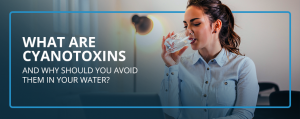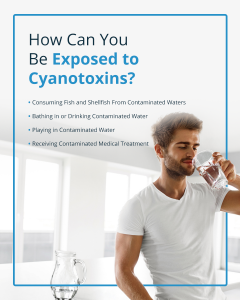What Are Cyanotoxins, and Why Should You Avoid Them in Your Water?
Posted by Kenton Jones on Feb 4th 2020

Have you gone to your favorite lake or pond in the summer only to find its clear, refreshing water overgrown with an unsightly, smelly green-blue scum? Harmful algal blooms (HABs), which are made from cyanobacteria, are becoming more and more common across the country.
According to the Natural Resources Defense Council (NRDC), the incidence of harmful freshwater cyanobacterial blooms has increased significantly over the past 40 years and poses an environmental threat in
every one of the 50 U.S. states.
In this guide, we'll discuss what cyanotoxins are, the potential risks, and how you can avoid being exposed to them.
What Are Cyanotoxins?
Cyanotoxins are a group of
toxins produced by cyanobacteria, which are more commonly known as blue-green algae. These bacteria live in fresh, brackish, and marine water. Like plants, they perform photosynthesis, turning sunlight into carbohydrates for food. They often accumulate in lakes, ponds, streams, and other surface waters where currents do not disturb them.
Cyanobacteria multiply rapidly in favorable environmental conditions. When they proliferate in this way, they form what are called blooms: large green or blue-green bacterial mats on the surface of the water. Some species of cyanobacteria have anatomical pockets that fill with gas and let them float to the surface in the right conditions. This floating ability allows them to aggregate in blooms.
Some cyanobacteria live in sediment at the bottoms of freshwater bodies but rise to the surface when storms disturb them. Other species can remain suspended at lower depths, giving the water a faint general discoloration.
Why Do Harmful Algal Blooms Form?
What are the right conditions for blooms to form? According to the Environmental Protection Agency (EPA) and the NRDC, favorable growing conditions are:
- Plentiful light: The intense, direct sunshine and long hours of daylight in the summer months often help create favorable conditions for the formation of algal blooms. Because cyanobacteria are photosynthetic organisms, concentrated sunlight helps them metabolize more food and grow quickly.
- Warm water: In warm water, cyanobacteria tend to grow faster than benign algae species. Warm water also creates a feedback loop for fostering the further spread of the algae. As the blooms grow, their dark surfaces absorb even more sunlight, which makes the water even warmer and even more hospitable to growth.
- High nutrient levels: High nutrient levels often occur when contaminated runoff reaches freshwater sources like lakes and ponds. Agricultural runoff is one of the primary sources of excess nutrients. Agricultural runoff, especially runoff composed of fertilizer or animal waste, typically contains high levels of nitrates, phosphates, and other chemicals that provide a feast for cyanobacteria when they reach surface waters. Urban storm runoff and wastewater discharge also contribute. When these chemicals flow into the water, they make it rich in nutrients. This eutrophication, or accumulation of excess nutrients, allows cyanobacteria to feed hungrily and multiply at exponential rates.
- Still water: Still water is beneficial for cyanobacteria growth because it allows warm water to rise to the top and cooler water to sink to the bottom. The top layer of warm water then fosters the development of cyanobacterial blooms. Drought, overconsumption of water for irrigation or drinking, and changes associated with the construction of dams and canals can all drop water levels and increase water stagnation.
- Climate change: Climate change contributes to the growth of harmful algal blooms in a number of ways. It increases the frequency and severity of drought and also contributes to the formation of extreme storms. Patterns of drought and storms, in turn, contribute to excessive agricultural runoff. Droughts allow excess nutrients to accumulate in the soil, and then storms sweep agricultural runoff across the landscape and deposit it in the water supply. Excessive carbon emissions contribute as well, because cyanobacteria can feed on the carbon dissolved in water.
Consequences of Cyanobacterial Overgrowth
As the cyanobacteria bloom, die off and decay, they consume much of the available oxygen in the water. In doing so, they choke out larger species like fish and plants. Harmful algal blooms often contribute to the death of much of the aquatic life in the rivers, ponds, or streams they occupy.

Cyanobacteria often produce toxins as they metabolize their food. Many species of cyanobacteria release their toxins into the water only when they die, though some species can release these toxins at all times. In either case, the toxins contaminate the water and also adhere to soil and organic matter, where they are difficult to remove.
Types of Cyanotoxins
Scientists group cyanotoxins into three different classes:
- Neurotoxins: These toxins cause neurological damage. Anatoxins, one class of cyanotoxin commonly found in U.S. freshwater bodies, are known to cause adverse neurological effects.
- Peptide Hepatoxins: These toxins affect the liver. The most commonly found cyanotoxins in U.S. freshwater bodies are microcystins and cylindrospermopsin, both of which cause profound liver damage.
- Dermatotoxins: These toxins irritate the skin and lungs.
How Can You Be Exposed to Cyanotoxins?
You can be exposed to cyanotoxins in water in several ways, including:

1. Consuming Fish and Shellfish From Contaminated Waters
Fish living in contaminated lakes and rivers consume cyanotoxins from their environment. When you eat those fish, you ingest the cyanotoxins as well, just as you would ingest mercury from fish that had ingested mercury from their environment. In a saltwater environment, ocean fish and shellfish, like mussels and clams, can transmit cyanotoxins as well. Even after the fish or shellfish are cooked, the cyanotoxins remain in their flesh.
2. Bathing in or Drinking Contaminated Water
If the water flowing into your home comes from a contaminated source, some cyanotoxins may be present. Up-to-date wastewater treatment systems can usually remove cyanotoxins, but insufficient treatment puts human health at risk.
Current estimates suggest that
30 to 48 million Americans get their water from sources subject to periodic contamination with cyanobacterial toxins. In 2014, 500,000 people in Toledo, Ohio, were unable to drink their tap water for three days because of harmful cyanobacterial blooms in Lake Erie that sickened more than a hundred residents.
If your home's water source becomes contaminated, you may ingest cyanotoxins in the water you drink or absorb them through your skin in the shower or bathtub.
3. Playing in Contaminated Water
Swimming, tubing, waterskiing, jet skiing — engaging in any of these activities in contaminated water exposes you to cyanotoxins. You can absorb the water through your skin, or you might accidentally swallow some. Cyanobacteria can also
accumulate in bathing suits and diving suits, where they break open and expose the skin to even more toxins.
Though most people are likely to steer clear of water overgrown with harmful algal blooms, cyanotoxins may be present in the water even if blooms are not apparent to the eye.
4. Receiving Contaminated Medical Treatment
Though this scenario is less common, cyanotoxin exposure can occur when clinics perform medical procedures using contaminated water. In 1996, in Caruaru, Brazil, more than a hundred patients at a kidney dialysis clinic began to experience blurred vision, eye discomfort, headaches, nausea, and vomiting after receiving
IV fluids containing cyanotoxin-contaminated water. One hundred of those patients went on to develop liver failure, and the majority of the cases were fatal.
The Potential Risks of Cyanotoxins
According to the EPA, exposure to cyanotoxins causes several adverse health effects, including:
- Liver impairment: People who have ingested hepatotoxins, cyanotoxins that affect the liver, can experience liver inflammation and hemorrhaging.
- Kidney impairment: People who have ingested cyanotoxins that affect the liver may also suffer damage to their kidneys.
- Gastrointestinal illness: The same cyanotoxins also cause gastrointestinal effects such as abdominal cramps, nausea, vomiting, and diarrhea.
- Neurological damage: The cyanotoxins that affect the nervous system cause neurological symptoms such as tingling, burning, and numbness of the extremities, drowsiness, incoherent speech, excessive salivation, and seizures. They can also lead to respiratory paralysis, which is often fatal.
- Skin irritation: Cyanotoxins often cause inflammation of the skin, usually in the form of a mild rash.
- Respiratory problems: Cyanotoxins can also irritate lung tissue and lead to pneumonia.
- Potential tumor formation: Cylindrospermopsin and microcystin have both been implicated in the growth of tumors, though more research is necessary to confirm this correlation.
- Mouth ulcers, blisters around the mouth, and joint pain: These symptoms can occur as well, along with a range of allergy symptoms.
It's not just humans who are susceptible to health risks from cyanotoxins. Pets can become sick too.
Cyanotoxin exposure in pets causes many of the same symptoms seen in humans — including difficulty breathing, excessive salivation, vomiting, diarrhea, fatigue, and seizures.
Because they are more likely to swim in and drink contaminated water, dogs are particularly vulnerable to illnesses caused by cyanotoxins. A recent report found
63 cases of canine toxicity and 20 canine fatalities across 13 states, all due to cyanotoxin exposure.
How to Tell If Your Drinking Water Contains Cyanotoxins
Though algal blooms sometimes produce a foul smell, the EPA cautions that cyanotoxins may be present in water without causing unpleasant odors or tastes. Generally, professionals must collect water samples and test them to determine whether cyanotoxins are present.
Biological tests and chromatographic tests are common methods of evaluation.
Biological tests like enzyme-linked immunoabsorbent assays (ELISA) can help assess the presence of cyanobacteria. ELISA kits work by using antigens, antibodies, and enzymes to provide an indicator of a specific substance, usually through a color change on a specific surface. They are commonly used in testing because they do not require prohibitive amounts of equipment or training. They often cannot identify specific strains of cyanotoxins, however.
Chromatographic tests for cyanotoxins are generally more precise. Gas chromatography and liquid chromatography combined with mass spectroscopy are useful for evaluating the presence of cyanotoxins in water:
- Gas chromatography: Gas chromatography uses inert gas to help separate a substance — such as a water sample — into its different components. This method is useful for detecting anatoxins, but cannot detect cylindrospermopsins and microcystins.
- Liquid chromatography: Liquid chromatography is similar to gas chromatography except that it uses liquid rather than an inert gas. It can reveal the presence of cyanotoxins by using fluorescence or ultraviolet detection. When liquid chromatography uses fluorescence detection, it is capable of detecting anatoxins only. When it uses ultraviolet-visible detection, it can detect all three main types of cyanotoxins.
- Mass spectrometry: Mass spectrometry involves measuring the mass of different components of a sample to determine what the sample is made of. Liquid chromatography used in combination with mass spectroscopy can detect all three main types of cyanotoxins.
What You Can Do to Protect Your Water

Water filtration and purification systems are excellent options for protecting your household from cyanotoxins. Different types of systems offer varying levels of effectiveness. How well a filtration system works against cyanotoxins also depends on the state of the toxins present.
Intact cells containing cyanotoxins are easier to filter out. Cyanotoxins from cells that have decayed and dissolved their toxins into the water are more difficult. Some common methods for removing or screening for cyanotoxins in your water include:
Reverse Osmosis
The EPA cautions that more research is necessary to determine the limits of reverse osmosis in filtering cyanotoxins. Generally, though, reverse osmosis is effective against both microcystins and cylindrospermopsins, two of the most prevalent types of cyanotoxins.
Activated Carbon Filters
According to the EPA, the effectiveness of activated carbon depends on the type of carbon and the size of its pores:
- Powdered activated carbon: The effectiveness of powdered activated carbon (PAC) varies tremendously with the type of carbon and its pore size.
- Wood-based activated carbon: Carbon from wood is the most effective at absorbing microcystins.
- Granular activated carbon: Granulated activated carbon (GAC) is effective against microcystins, but less so against cylindrospermopsins and anatoxins.
- Solid carbon block: Solid carbon block filters are effective at significantly reducing the concentration of cyanotoxins. Multpure's solid carbon block filters meet EPA specifications for cyanotoxin reduction. The Multipure Aquaperform, in particular, has the same carbon block formation as our heavy-duty water Aqualuxe water purifier and is confirmed to reduce microcystin concentrations in water. It is also particularly effective against arsenic. Though the Multipure Aquaversa contains a different carbon block formulation and has not been rigorously tested against cyanotoxins, it too offers the high-performance absorptive technology of carbon blocks. It can help reduce cyanotoxin concentrations in home water.
Ozone Treatment
Ozone treatment is highly effective against all three main types of cyanotoxins. However, ozone treatment is relatively
expensive and complex. Ozone treatment is also reactive, so many homeowners would rather use safer substances.
Ultraviolet (UV) Radiation
UV light systems also work well to reduce cyanotoxin concentrations. However, effective reduction requires such high doses of UV radiation that the practical applications of this method are limited.
Water Purification
Water purification systems are the best option for removing cyanotoxins from household water. They are specifically engineered to remove microscopic particles and are effective against a host of chemical contaminants as well.
When you're thinking about how to purify water in your home, the
Multipure Aqualuxe is an excellent solution. It combines traditional carbon filtration technology with Multipure's patented PureBlock microbiological filtration technology. It is highly effective against viruses, bacteria and other microbiological contaminants and can provide your home with clean, pure, safe water for every household use.
The Aqualuxe has proven to
perform effectively against microcystins. However, if a cyanobacterial bloom occurs in your water supply, other types of cyanotoxins may infiltrate as well. If you know of a cyanobacterial risk in your area, contact authorities for guidance on whether your purified tap water is safe to drink.
Contact Multipure for Cyanotoxin Filtration and All Your Water Filtration Needs

The importance of water purification and filtration in the home cannot be overstated. To help keep your family safe from waterborne cyanotoxins and other biological and chemical contaminants, make Multipure your trusted source for
home drinking water systems.
Our Aqualuxe, Aquaperform, and Aquaversa systems install easily under your sink or on your countertop to give your family fresh, clear water and protection against cyanotoxin contamination. We also offer a
whole-house filtration system and several shower and bath products for filtering chlorine and chloramine. Our unparalleled filter performance helps keep your water clean and healthy.
Contact us today to learn more.

